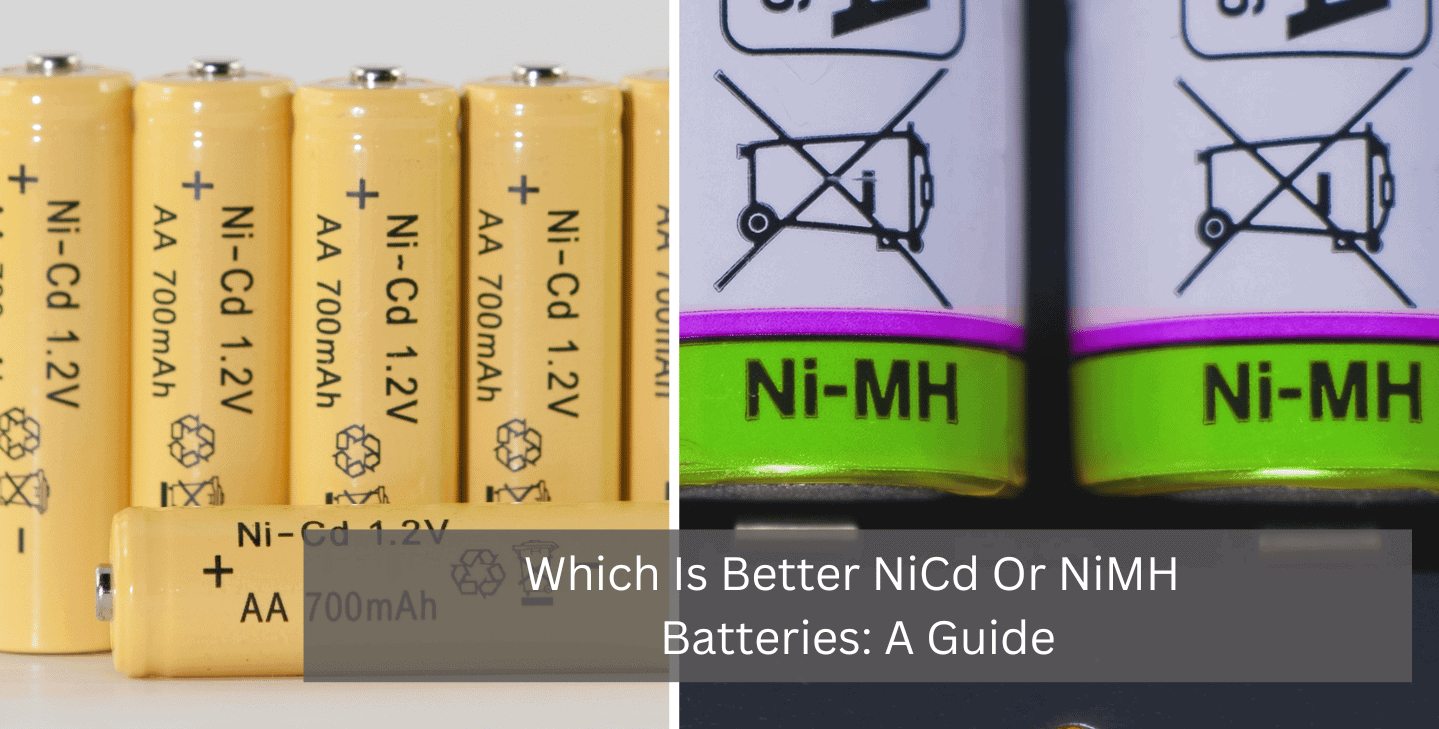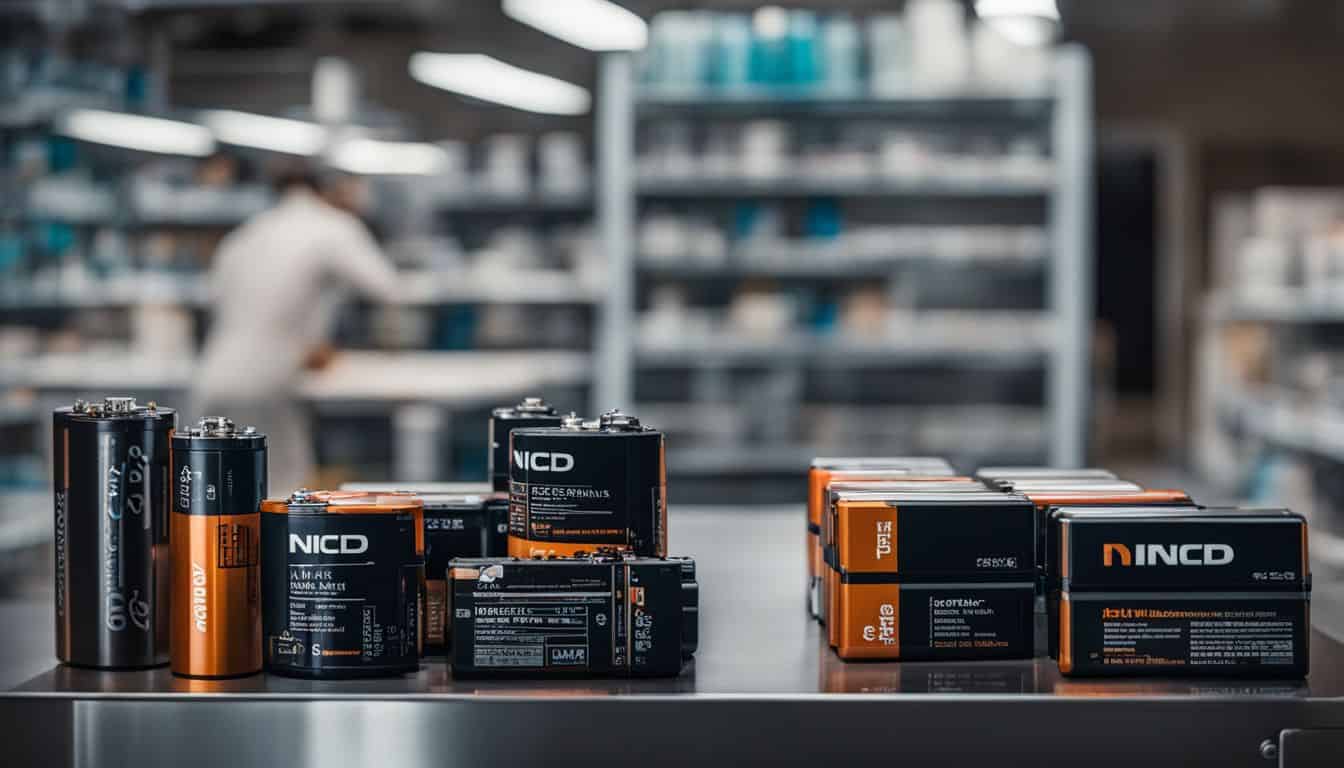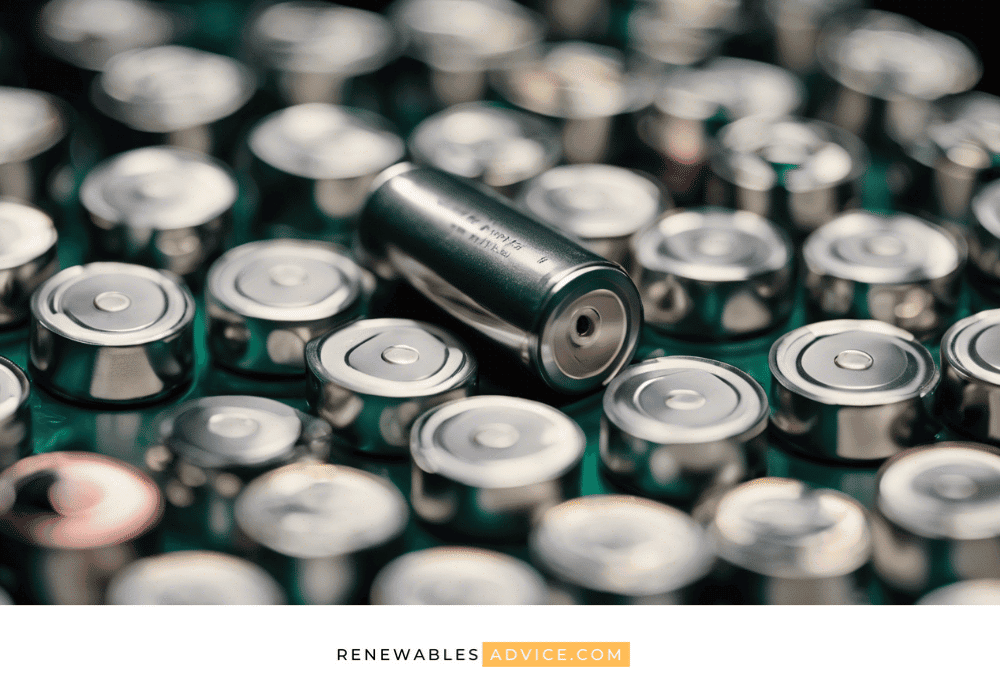Which Is Better NiCd Or NiMH Batteries: A Guide
Which Is Better NiCd Or NiMH Batteries: A Guide
Which Is Better NiCd Or NiMH Batteries: A Guide

In this comprehensive guide, we dive into the heart of a common dilemma in the world of electronics: choosing the right rechargeable batteries. Whether it's for your digital camera, power tools, or everyday gadgets, the type of battery you select is crucial. We're comparing Nickel Cadmium (NiCd) and Nickel Metal Hydride (NiMH) batteries to provide clarity in this often confusing decision.
At the crux of this comparison are essential factors like charge efficiency, discharge rates, and overall use longevity. We'll explore how the memory effect influences your battery choice, a phenomenon where a battery loses its maximum energy capacity when repeatedly charged after being only partially discharged. This effect is notably prominent in NiCd batteries but is less of an issue in NiMH batteries.
Understanding the difference between these two types of batteries is key to making an informed choice. For instance, NiCd batteries are known for their robustness and ability to deliver consistent power even under strenuous conditions, whereas NiMH batteries offer a more environmentally friendly option with a higher energy density.
As we delve into the world of the rechargeable battery, remember that the best choice depends on your specific needs and priorities. Our guide aims to illuminate the path toward a battery that not only powers your devices efficiently but also aligns with your personal or professional requirements. To discover which battery truly reigns supreme in power, sustainability, and reliability, read on...
Key Takeaways
- NiMH batteries have a higher capacity than NiCd, meaning they store more energy and are ideal for high-drain devices.
- Unlike NiCd, NiMH batteries are more eco-friendly as they don't contain toxic cadmium.
- NiCd batteries offer a high discharge rate that's perfect for tools needing bursts of power.
- The environmental impact of disposing of NiCd batteries is significant due to their toxic materials.
- While they have good durability, NiMH batteries may not last as long in terms of overall lifespan compared to rugged NiCd options.
What are the Differences Between NiCad and NiMH Batteries?
When deciding whether Nickel Cadmium (NiCad) or NiMH batteries are the superior choice, understanding their differences is crucial. Let's delve into how these two types of rechargeable batteries compare in terms of capacity and environmental considerations to better determine which one aligns with your needs.
1. Capacity and Durability
Ni-MH batteries boast a higher capacity than their NiCad battery counterparts. This means they can store more energy and power devices longer between charges. They are perfect for high-drain gadgets like digital cameras and power tools because of this extra juice.
But it's not just about the power they hold; NiMH cells also handle overcharging better, making them less likely to suffer damage if left plugged in too long.
Durability is where things get tricky. NiCd batteries tend to be tougher and cope well with rough treatment. They keep working in extreme temperatures, both hot and cold, which can give them an edge in outdoor or demanding environments.
On the other hand, while NiMH cells may not always match up on ruggedness, they do come without a memory effect—meaning you won't see reduced performance if you recharge them before they're fully drained.
2. Environmental Impact
Moving from capacity and durability, we see that the environmental impact of batteries is crucial. NiCd batteries contain cadmium, a toxic metal that can pollute the environment if not disposed of correctly.
On the other hand, NiMH batteries are free from this toxic chemical. This makes them a safer choice for our planet.
Modern NiMH rechargeable batteries show their green side by avoiding mercury and lead. They also resist overcharging which lessens their environmental footprint. Because they have a higher energy density, they last longer between charges, reducing energy use over time.
In contrast, nickel-cadmium cells pose health risks due to their toxic components, calling for careful recycling to prevent harm to ecosystems and human health.
Having explored the key differences between NiCad and NiMH batteries, let's delve deeper into the specific advantages and challenges presented by NiCad batteries.

What are the Pros and Cons of the NiCad Battery?
NiCd batteries still hold a unique position with the technological landscape constantly evolving. Offering robust discharge rates and a commendable shelf life; yet, their environmental footprint is a pressing concern—how does one weigh these contrasting factors? Let's delve into the intricate balance of advantages and disadvantages that Nickel-Cadmium batteries present.
1. Higher Discharge Rate
NiCd batteries stand out for their ability to handle high discharge rates. This makes them a go-to choice for professional-grade power tools and devices that need quick, strong bursts of energy.
Unlike Ni-MH batteries which cut power more gradually, NiCad cells are reliable when it comes to sustaining performance throughout their charge cycle.
Professionals rely on the consistent output of NiCd batteries in emergency situations or demanding environments. They deliver power effectively until depletion, maintaining equipment readiness and response time without faltering under load.
The superior discharge rate also ensures critical applications won’t suffer from a sudden loss of energy at crucial moments.
2. Longer Shelf Life
The NiCd battery comes out ahead in longevity. They are more resistant to overcharging without significant harm, which prolongs their shelf life. This is crucial for people who rely on durable and long-lasting power sources for their equipment.
Regular use of a charger doesn't shorten a NiCd battery's lifespan as it might with other types.
Consumers should note that while NiCd batteries have their strengths, environmental friendliness isn't one of them. Moving on to the risk of toxic materials reveals why this is an important consideration.
3. Risk of Toxic Materials
While NiCd batteries offer a longer shelf life, one must consider their environmental footprint. These batteries contain cadmium, known for its toxic effects on both humans and the environment.
If disposed of incorrectly, nickel-cadmium (NiCad) batteries can pollute soil and water. This happens when heavy metals leak from the battery's casing. A study in PubMed Central called ‘The Effects of Cadmium Toxicity’ highlighted that Cadmium, poses serious health risks to humans and animals, primarily through consumption of contaminated food and water, and inhalation. It accumulates in living organisms, leading to an increased risk of various cancers and osteoporosis, and can cause significant liver and kidney damage due to its ability to induce oxidative stress and disrupt cellular processes (1).
Consumers using NiCd batteries need to follow strict disposal guidelines. By doing this, they prevent harmful substances from entering ecosystems. But even with careful disposal, there is still a risk.
Now that we've examined the characteristics of NiCad batteries, it's time to weigh the benefits and drawbacks of their Nickel-Metal Hydride counterparts.
What are the Pros and Cons of Nickel-Metal Hydride Batteries?
Exploring the world of nickel-metal hydride batteries highlights some key advantages, unveiling a landscape where enhanced capacity meets eco-consciousness, yet certain trade-offs become evident. Let's delve into the dualities that define NiMH technology, from its commendable energy density to concerns over longevity—a narrative crafted for consumers weighing up battery options with discernment.
1. Higher Capacity
The Ni-MH battery boasts a greater storage capacity than their NiCad battery counterparts. This means they can power devices for longer periods on a single charge. Professionals in various fields, from medical to industrial, benefit from this extended usability without the need for frequent recharging.
Their ability to hold more energy makes them highly suitable for high-drain devices such as digital cameras and GPS units. With advancements in technology, nickel metal hydride batteries are proving crucial where enduring power is essential.
The next section will explore how being more eco-friendly sets NiMH apart from NiCd options.
2. More Eco-friendly
NiMH batteries stand out for their green credentials. Unlike NiCd batteries, they don't contain cadmium, a toxic heavy metal that harms the environment. This makes disposal safer and recycling processes less hazardous.
Choosing NiMH over NiCd contributes to a healthier planet by cutting down on harmful waste.
Consumers often prefer nickel-metal hydride options for eco-conscious applications. By picking these batteries, you're selecting technology that aligns with modern environmental standards.
Your choice supports sustainable practices and demonstrates responsibility towards our ecosystem.
3. Decreased Durability
Moving from their environmental benefits, it's essential to address the lifespan issues of the NiMH battery. They have a known shortcoming in this area compared to NiCd counterparts.
You'll find that NiMH options don't last as long before they need replacing. This is reflected in both their shorter overall lifespan and reduced cycle life.
Buyers should note that although NiMH cells may offer higher capacities, they fall behind on endurance. Frequent charges can wear them out more quickly than one might expect.
As such, devices powered by NiMH batteries may not sustain high performance for as many recharges over time.
With a clear understanding of the pros and cons of both battery types, let's compare their environmental footprints to see how they stack up against each other.

Environmental Impact Report: NiCd vs. NiMH Batteries
Nickel-Cadmium (NiCd) and Nickel-Metal Hydride (NiMH) batteries present distinct environmental footprints, influencing our ecosystem in various ways.
From their inception in the manufacturing process to their ultimate disposal or recycling, this section provides a comprehensive analysis.
Manufacturing Process
- NiCd Batteries:
Let's turn our attention to how Nickel-Cadmium (NiCd) batteries come to life. The journey begins with the extraction of cadmium and nickel, two core components. The process of mining these materials is not just a heavy undertaking; it also poses significant environmental challenges. The excavation of cadmium, in particular, raises concerns due to its toxic nature and potential for environmental contamination.
Mining isn't the end of the story. Transforming these raw materials into battery components is an energy-intensive process. It demands a substantial amount of power, contributing to the batteries' overall carbon footprint. This phase of production, while crucial for creating the batteries, is a notable contributor to greenhouse gas emissions.
Understanding the environmental implications of these stages is vital. It allows us to grasp the full ecological cost of NiCd batteries, guiding us toward more informed choices in our technological and environmental pursuits.
- NiMH Batteries:
Now, let's explore the creation of the Nickel Metal Hydride battery. These batteries also rely heavily on nickel, similar to NiCd batteries. However, NiMH batteries incorporate rare earth metals, which adds a layer of complexity to their production.
The extraction of these materials, particularly rare earth metals, is a meticulous process. It's not only labour-intensive but also has significant environmental stakes. The mining of these metals can lead to habitat disruption, water pollution, and other ecological impacts.
When we talk about the energy used to make NiMH batteries, it's a mixed bag. The manufacturing demands considerable energy, much like NiCd batteries. However, the overall environmental footprint is nuanced. The absence of toxic cadmium in NiMH batteries offers a slight edge in terms of toxicity and disposal concerns.
In comparing NiMH to NiCd, while both have substantial energy requirements and emissions during production, NiMH batteries present a somewhat lesser environmental burden due to the absence of cadmium. This comparison is crucial in understanding the broader environmental implications of our battery choices.
Usage Phase
- NiCd Batteries:
During their usage phase, NiCd batteries exhibit certain characteristics that define their environmental impact. One of the key factors is their energy efficiency. While NiCd batteries are reliable, their energy efficiency is somewhat moderated by the memory effect. This phenomenon can lead to reduced energy efficiency over time, as the battery may lose its ability to achieve a full charge if not fully discharged before recharging.
This memory effect not only influences the battery's performance but also impacts its energy consumption. Batteries experiencing this effect require more frequent charging, which can increase the energy used over the battery's lifespan.
There's a significant environmental concern associated with NiCd batteries: the potential for cadmium leakage. Cadmium is a toxic heavy metal, and its release into the environment can have serious ecological consequences. This risk becomes particularly pertinent when batteries are not disposed of correctly, leading to the possibility of cadmium contaminating soil and water sources.
Understanding these aspects of NiCd batteries' usage phase is vital for assessing their overall environmental footprint, informing users and manufacturers about the broader implications of choosing and utilising these batteries.
- NiMH Batteries:
During the usage phase, Nickel-Metal Hydride battery demonstrates a notable advantage in terms of energy density compared to their NiCd counterparts. This higher energy density means that NiMH batteries can store more energy and, consequently, power devices for longer periods on a single charge. This attribute translates to less frequent charging, which inherently reduces the energy consumption associated with maintaining the battery's charge over its lifecycle.
Another significant environmental benefit of NiMH batteries is their composition. Unlike NiCd batteries, NiMH cells do not contain toxic heavy metals such as cadmium. This absence is crucial from an environmental safety perspective, as it mitigates the risks associated with heavy metal leakage during the battery's usage. Without the presence of these hazardous materials, NiMH batteries pose a lesser threat to the environment, reducing concerns about soil and water contamination during their use.
The environmentally friendly nature of NiMH batteries, combined with their efficient energy usage, underscores their appeal as a sustainable choice in the realm of rechargeable batteries. These characteristics are essential for users and manufacturers alike to consider when evaluating the environmental impact of battery technology during its operational phase.
Disposal and Recycling
- Commonalities:When the lifecycle of both NiCd and NiMH batteries concludes, their disposal and recycling become pivotal. Proper disposal is crucial to avoid landfilling, where batteries can leak harmful substances into the environment. The challenges and processes involved in battery recycling are significant yet essential for mitigating environmental harm.Recycling batteries is a complex process. It involves sorting, chemical treatment, and material recovery, each step demanding meticulous care to ensure environmental safety and material efficiency. This process helps reclaim valuable metals and materials, reducing the need for new raw material extraction and thus diminishing the overall environmental footprint.However, recycling rates for batteries are not as high as they could be, partly due to a lack of awareness or convenient recycling options. Ensuring batteries end up in the right recycling streams is a collective responsibility shared by consumers, manufacturers, and waste management entities.The importance of proper battery disposal cannot be overstated. Incorrect disposal can lead to batteries ending up in landfills, where they can corrode and release toxic substances into the soil and groundwater. Such environmental contamination poses risks to wildlife, ecosystems, and even human health.
Both NiCd and NiMH batteries have recyclable components, and promoting and facilitating their recycling can significantly reduce their environmental impact. Encouraging consumers to participate in battery recycling programs and increasing awareness about the importance of proper battery disposal are key steps in closing the loop on battery waste and fostering a more sustainable approach to battery usage and end-of-life management.
- NiCd Batteries:
- Cadmium Toxicity: NiCd batteries contain cadmium, a heavy metal with significant environmental and health risks. Improper disposal can lead to cadmium leakage, contaminating soil and water, and posing threats to wildlife and human health.
- Recycling Imperatives: Recycling NiCd batteries is crucial to prevent cadmium pollution. The recycling process involves carefully separating and treating battery components to recover cadmium.
- Cadmium Recovery: During recycling, cadmium is extracted and either reused in new batteries or disposed of in a manner that minimises environmental impact, ensuring it does not enter the ecosystem. The article titled 'Cadmium Recovery from Spent Ni-Cd Batteries: A Brief Review' provides a comprehensive overview of the recovery of cadmium from spent Ni-Cd batteries, emphasising the importance of developing effective technologies for Cd recovery due to the increasing demand for Cd-containing batteries and Cd's critical raw material status. It discusses pyro- and hydro-metallurgical methods, highlighting the efficiency and environmental benefits of Cd recovery. The study underscores the significance of recycling and proper disposal of Ni-Cd batteries, showcasing the potential for energy savings and reduced environmental impact through efficient recovery processes (2).
- Safe Disposal: Proper disposal channels ensure that NiCd batteries are directed to appropriate recycling facilities, preventing landfilling and the associated risks of cadmium leakage.
- Consumer Role: Users of NiCd batteries play a key role in this cycle, responsible for handing over spent batteries to certified recycling centers or collection points dedicated to handling hazardous waste.
- NiMH Batteries:
- Reduced Hazard: NiMH batteries are less hazardous than NiCd counterparts as they lack toxic heavy metals like cadmium. This makes them safer for the environment when it comes to disposal.
- Recycling Benefits: Recycling NiMH batteries allows for the recovery of valuable materials, reducing the need for new raw material extraction and lessening environmental impact.
- Material Recovery: The recycling process for NiMH batteries focuses on reclaiming nickel and other metals, which can be used in the creation of new batteries or other products.
- Environmental Advantages: By recycling NiMH batteries, we divert them from landfills, preventing potential soil and water pollution and contributing to a more sustainable ecosystem.
- Recycling Rate Encouragement: Increasing the recycling rate of NiMH batteries is crucial. Awareness and accessibility to recycling programs are key factors in enhancing these rates and maximising environmental benefits.
After considering the environmental impacts of NiCd and NiMH batteries, we arrive at the crucial question: which battery type aligns best with your needs and values?
Conclusion: Which Rechargeable Battery is Right for You? Ni-MH Batteries or Ni-Cd Batteries?
In concluding our exploration of NiCd and NiMH batteries, the central question remains: which is better and right for you? Delving into this decision, we've unpacked the differences in capacity, charge efficiency, and environmental impact. It's clear that nicad batteries and ni-mh battery options present a diverse array of strengths and weaknesses.
For those prioritising environmental sustainability, the NiMH battery emerges as a compelling choice. Their lack of toxic substances like cadmium positions them as a friendlier option for our environment. This consideration is crucial in today's eco-conscious world. However, it's important to acknowledge that while NiMH batteries score high on the green scale, they may fall short in terms of ruggedness and longevity compared to their NiCd counterparts.
On the other hand, nicad batteries hold their ground with a reliable charge cycle and durability, especially in demanding conditions. Their ability to endure extreme temperatures and rough use makes them a solid choice for high-impact applications like power tools. Yet, the environmental cost of using NiCd batteries—from production to disposal—can't be overlooked.
When it comes down to the number of charges and overall lifespan, NiCd batteries might have an edge, but NiMH batteries offer a higher energy density and a safer environmental footprint. It's a trade-off between power and responsibility.
Ultimately, your choice hinges on personal priorities and specific use cases. If you seek a battery that harmonises with environmental values, then NiMH is your go-to. But if your focus is on enduring power and resilience, particularly for professional or heavy-duty tasks, then nicad batteries could be your ideal match. Remember, the right battery powers your devices and aligns with your values and needs. Choose wisely and power up your life responsibly.
Reference List
(1) Genchi G, Sinicropi MS, Lauria G, Carocci A, Catalano A. The Effects of Cadmium Toxicity. Int J Environ Res Public Health. 2020 May 26;17(11):3782. doi: 10.3390/ijerph17113782. PMID: 32466586; PMCID: PMC7312803.
Licensed under CC BY 4.0 DEED. No changes were made to the material.
(2) Blumbergs, E.; Serga, V.; Platacis, E.; Maiorov, M.; Shishkin, A. Cadmium Recovery from Spent Ni-Cd Batteries: A Brief Review. Metals 2021, 11, 1714. https://doi.org/10.3390/met11111714
Licensed under CC BY 4.0 DEED. No changes were made to the material.
